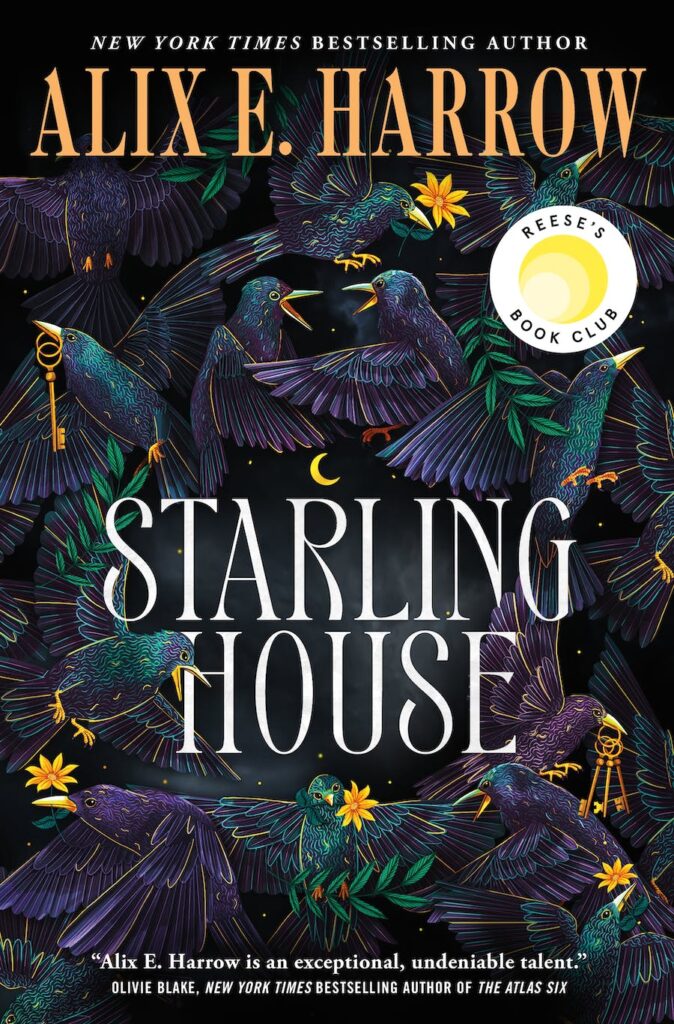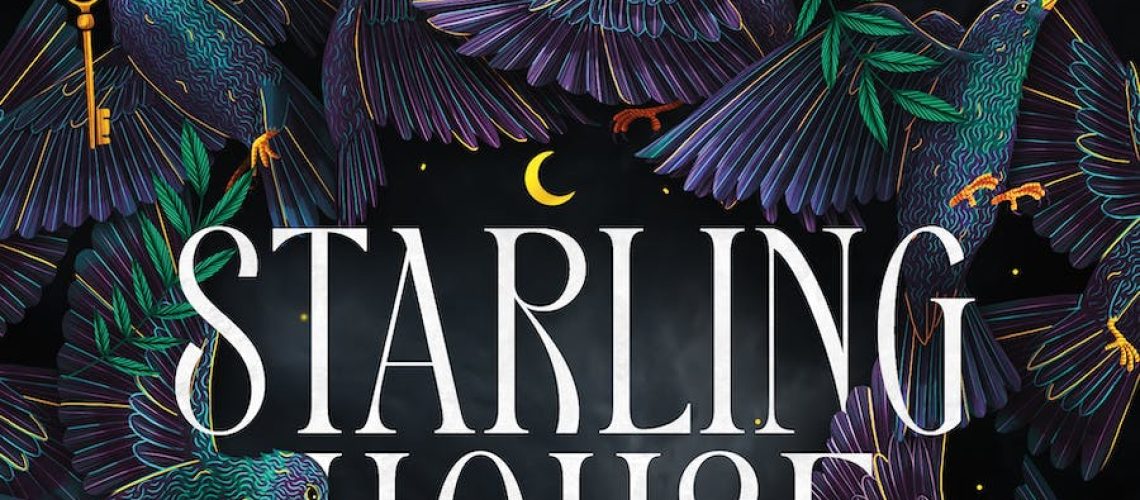We are excited to bring you an interview with Alix E. Harrow about her newly released novel Starling House, out now from Tor Books.
“A grim and gothic new tale from author Alix E. Harrow about a small town haunted by secrets that can’t stay buried and the sinister house that sits at the crossroads of it all.”
In addition to this interview, you can read an excerpt from the novel online at Tor.com.
For more details on the novel and its author, please read the official book blurb and author information that follow the interview. Thank you again to Alix for doing this interview with us and giving us a perfect autumn read!
- Starling House crosses and transcends genres. It’s a fantasy with touches of mystery, romance, and horror, all united with gothic themes and atmosphere. I saw you describe it somewhere as “What if A24 did Beauty and the Beast?”, which I liked. What was the starting point in all of this for the novel: the gothic, the characters, that pull of fairy tales present in much of your work, or something else?

It’s funny—every time I answer the question of where this book started, I find myself telling a slightly different story. It started when I was staying on my grandma’s farm in Allen County, Kentucky, thinking about sinkholes and caves and everything Kentucky has tried to bury in them. It started when I was a kid, listening to John Prine’s “Paradise.” It started when we bought an abandoned house in Madison County, and it started when we decided to leave it.
Really, I guess, the answer is that it started with Kentucky, and with the concept of home. Everything about the genre—the romance, the horror, the fairy tale elements—was really just me trying to fit all the different feelings I have about my home into one book.
- This is your first novel set in your home state of Kentucky, and the first set in contemporary times. What in the elements of Starling House made this setting a necessary or perfect fit, and are there other stories already in your mind about Kentucky?
So I’ll confess that, although I obviously love historical fiction, I do get a little bit itchy at how often the American South is portrayed in the permanent, unchanging past. There’s a sense that authentic southern-ness ends somewhere in the mid-50s—and let’s all take a moment to wonder what happened after the ’50s to damage the wholesome, nostalgic image of the South—and that everything after that is reduced, diluted in some way. Like, try to picture a southern gothic with cell phones; I couldn’t, so I knew I had to write a southern gothic with cell phones.
- You’ve described yourself as “not a haunted house person,” and while the novel may not be a gothic haunted house story in the classic sense, it is a refreshing take on haunted characters and houses with seeming consciousness and power. Were there “haunted house” tropes you intentionally tried to stay away from, or decide to keep?
So the needle I was trying to thread was between the sentient house of the gothic (terrifying, hungering, the opposite of the concept of home) and the sentient house of fairy tales (enchanting, cozy, the perfect fulfillment of the concept of home). I stole tropes from both, but tried to interpret them differently? So like, a door slams in a haunted house because it’s evil; a door slams in Starling House because it’s a brat.
- This may not be accurate to your intentions, but the start of the novel reminded me as a play on the start of Daphne du Maurier’s Rebecca. Were there specific gothic influences to Starling House beyond gothic fairy tales?
Oh, yeah. Later in the book I even stetted the spelling of “dreamt” as a direct reference! I actually read a ton of gothics (Beloved, some Faulkner, Housekeeping, Sing, Unburied, Sing, Mexican Gothic, Summer Sons) as aesthetic research, early on, so hopefully there are little nods to all of them.
- At least two of Opal’s relationships in the novel deal with both the failings and successes in being a non-traditional parental figure to another, in both directions of her being the ‘parent’ (with Jasper) and her being the ‘child’ (with Bev.) Did you pull any of this from your own life as mother and daughter?
Some—I mean, I have little brothers, who I feel unnecessarily bound to fuss over—but mostly I think it came from my own (fairly traditional) experience as a parent of two kids. I want to write about all the emotions of parenting—the worry and terror, the fumbling love, the daily work of caretaking–but I despise the idea that those experiences only exist within the traditional two-parent biological family. Similarly, the popular reduction of “found family” to “a group of hot young urban gays” doesn’t look anything like my found family. So I ended up with this multi-generational set of relationships, some blood, some not, that make up something like a family.
- Opal’s relationship with Arthur personifies the idea of fearing what you desire, yet finding ways to make it positive and work. Yet, Eleanor Starling’s story also could illustrate how trauma can warp desires and remove fears to the opposite effect. Did you want to explore both ends of that gothic spectrum specifically in Starling House?
The gothic as a genre is totally about desiring what you fear! And I wanted a gothic heroine who wasn’t punished for giving in to that desire, as so many of them are. To me, Eleanor is what happens when the fear wins out.
- Elizabeth Blaine makes a wonderful villain, but it also makes me wonder how she became the way she is. I could see more stories with her or the shady organization she works for. Have you developed more backstory to her character that didn’t make the scope of the novel?
Not even a little bit, to be honest. I think the problem with me and villains is that I’m fundamentally bored by them, because they’re so fundamentally boring in real life? Like, actual villains don’t commit cruelties because of their fascinating backstories, they do it because it gets them money, power, and comfort. Baine is no less culpable or more interesting because she happens to be a white woman doing the same thing.
- Like your other work, there is a great flow and entertaining readability to Starling House, with the text still being evocative and prose beautiful. I think it’s something your fans pick up on and appreciate. I’m guessing it doesn’t start that way though! What does your editing usually entail in order to get things sounding right to what you want?
I think the answer is that I just write…slowly. Like, obnoxiously, counter-productively slowly. There’s the outline, and then a rough draft of the scene, but I can’t actually leave the scene alone until I’ve wrestled every stupid sentence into something I like.
- You’ve had education as a cultural historian and your prior novels have been set in distinct historical periods. While Starling House still may have involved some more recent kinds of historical research, the novel’s biggest academic vibes come from its structure with occasional footnotes and the authorial (biographical?) intent behind the text’s purported source. What led you to doing this with the novel?
I mean, it is a contemporary novel, but it’s a contemporary novel looking backward over one shoulder. I think one of the things you never shake about studying history is the certainty that the present is only explicable to the extent that you’ve explicated the past—so there had to be footnotes and interviews and letters, little glimpses of Kentucky’s past.
But because the past isn’t monolithic—because history isn’t a single, objective narrative—the book became a sort of collage of sources and voices.
- I really enjoyed the lovely Easter egg tidbits in the novel, such as in the Wikipedia entry that cites “Beastly Appetites: Queer Monstrosity in E. Starling’s Text” by one L. Mandelo for The Southern Gothic Critical Reader from Salem Press. For those who want to be on the hunt, how many of these did you include? Can Lee write this paper now too, please?
Lee’s is just the easiest to find, because his last name is so recognizable. But you’d find some other Kentucky writers in there, if you looked, and some Kentucky family and friends that only I’d know.
And Lee hasn’t written that article, but he has written a novella explicitly about queer monstrosity in Kentucky. The Woods All Black is out in 2024, and if there’s one book I wish I could make people read alongside Starling House, it would be that one.
- And the obligatory final question: Is there anything you’d like to let us know about Starling House or about your upcoming projects? Has A24 optioned this yet?
I don’t think I can announce any upcoming projects, other than my next full-length novel, which is about a big sad lady knight stuck in a bad time loop. Honestly, I was always going to write a book about a girl with a sword.
Official Book Blurb:
“Eden, Kentucky, is just another dying, bad-luck town, known only for the legend of E. Starling, the reclusive nineteenth-century author and illustrator who wrote The Underland―and disappeared. Before she vanished, Starling House appeared. But everyone agrees that it’s best to let the uncanny house―and its last lonely heir, Arthur Starling―go to rot.
Opal knows better than to mess with haunted houses or brooding men, but an unexpected job offer might be a chance to get her brother out of Eden. Too quickly, though, Starling House starts to feel dangerously like something she’s never had: a home.
As sinister forces converge on Starling House, Opal and Arthur are going to have to make a dire choice to dig up the buried secrets of the past and confront their own fears, or let Eden be taken over by literal nightmares.
If Opal wants a home, she’ll have to fight for it.”
Official Author Information:

Alix E. Harrow is the NYT-bestselling author of The Ten Thousand Doors of January, The Once and Future Witches, Starling House, and various short fiction, including a duology of retold fairy tales (A Spindle Splintered and A Mirror Mended). Her work has won a Hugo and a British Fantasy Award, and been shortlisted for the Nebula, World Fantasy, Locus, Southern Book Prize, and Goodreads Choice awards.
She’s from Kentucky, but now lives in Charlottesville, Virginia with her husband and their two semi-feral kids.
Her writing is represented by Kate McKean at Howard Morhaim Literary Agency.
Author Photo Credit: Elora Overbey, 2023
Cover Art Credit: @micaelaalcainodesign







